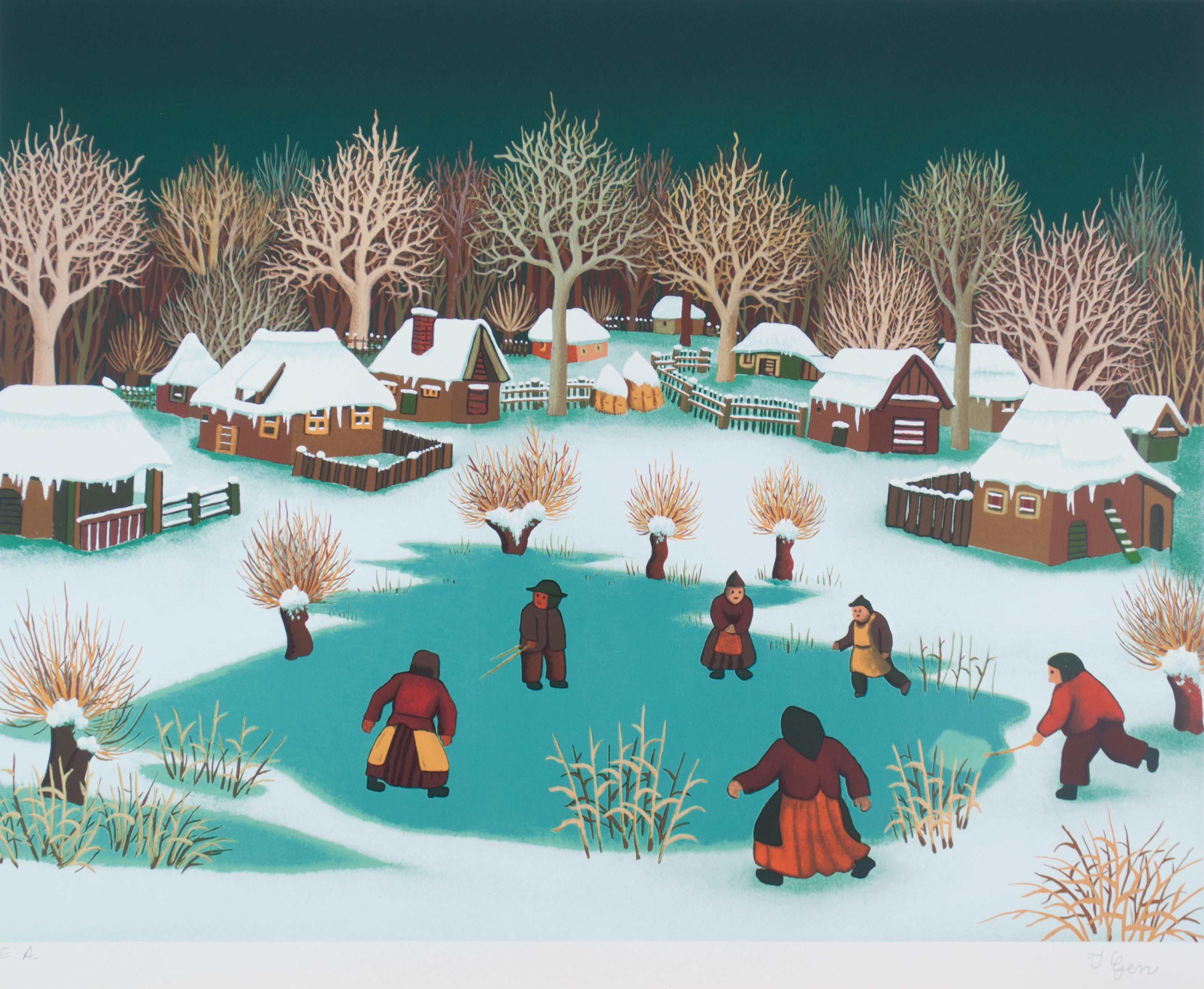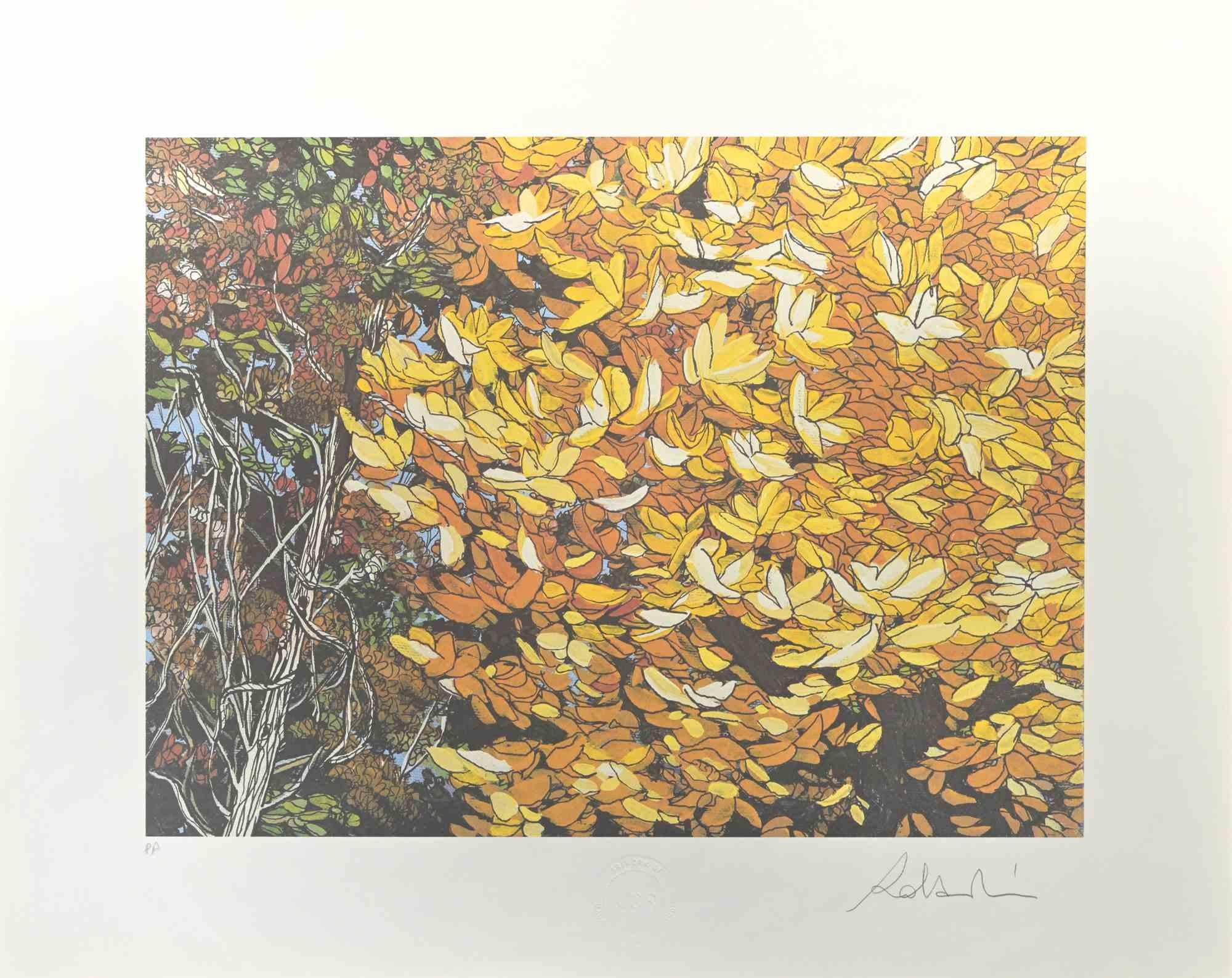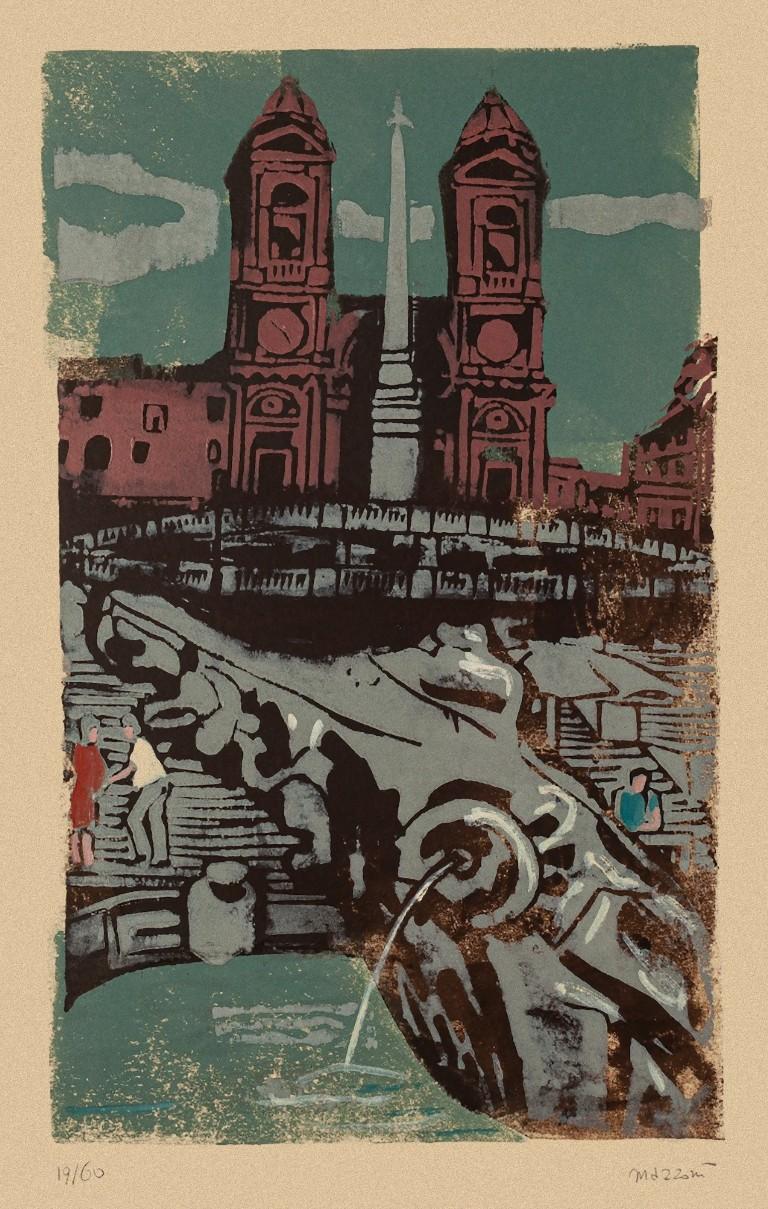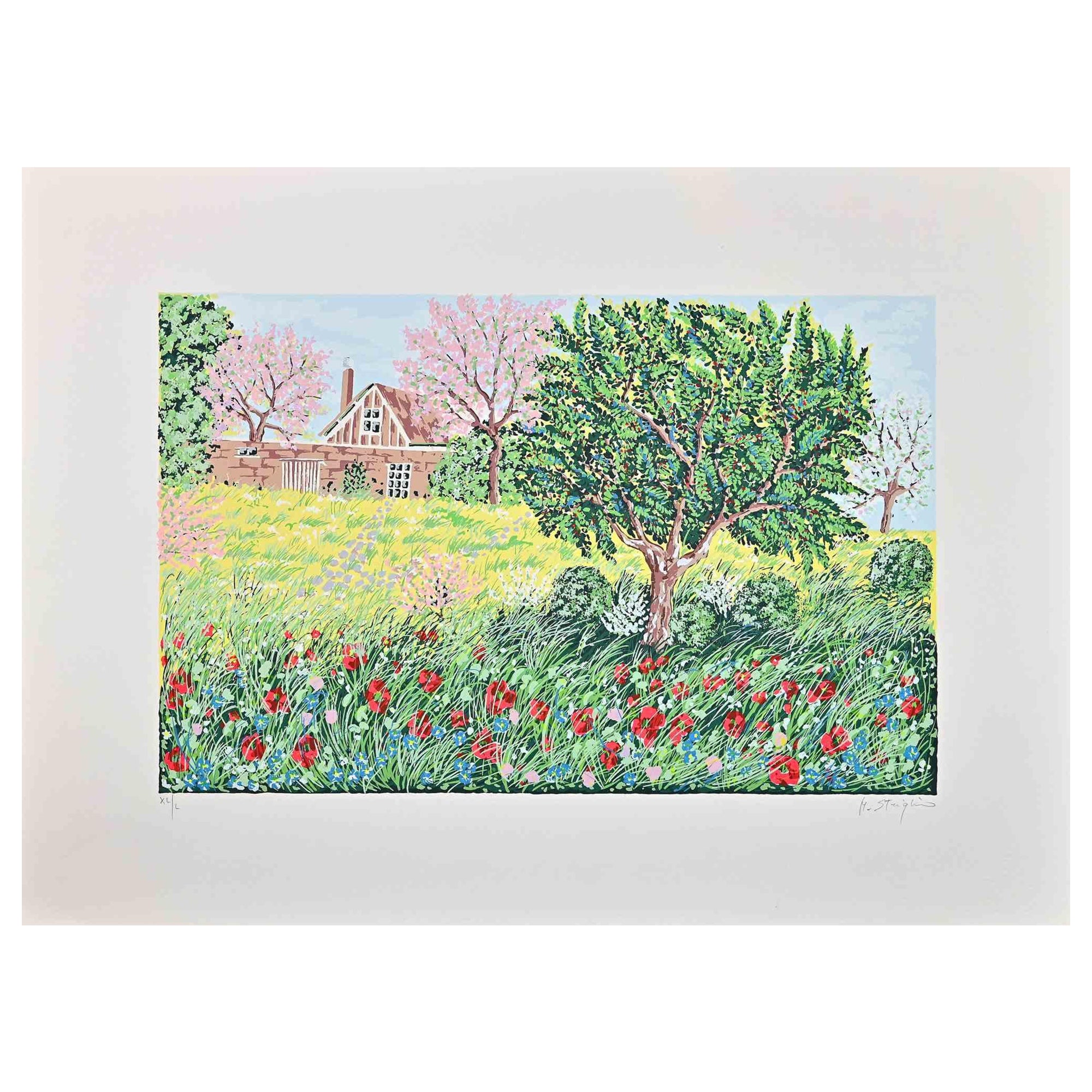Items Similar to Untitled
Want more images or videos?
Request additional images or videos from the seller
1 of 5
Ivan LackovicUntitledunknown
unknown
About the Item
Original color silkscreen, unknown year.
Ivan Lacković was a Croatian naive self-taught painter and printmaker, known for his artworks of rural village life, flowers, still life and rare portraits, with a lyrical and surreal atmosphere. He also illustrated many books of prose and poetry. First artworks were just clear depictions of winter rural landscapes, but later he started to insert motives with a symbolic meaning. This is an idyllic scene of winter magic near the village with people playing with snow on a frozen lake. He celebrates the beauty of his homeland, saying for his lyrical scenes: “I have given man a special place in nature, I have elevated him to the throne by making him part of nature itself…” The humans in my paintings are sustained by the melancholy colors of spring, summer, autumn, and winter.”
- Creator:Ivan Lackovic
- Creation Year:unknown
- Dimensions:Height: 35.44 in (90 cm)Width: 27.56 in (70 cm)
- Medium:
- Movement & Style:
- Period:
- Condition:
- Gallery Location:Ljubljana, SI
- Reference Number:
About the Seller
No Reviews Yet
Vetted Seller
These experienced sellers undergo a comprehensive evaluation by our team of in-house experts.
Established in 1973
1stDibs seller since 2022
Typical response time: 1 to 2 days
- ShippingRetrieving quote...Ships From: Ljubljana, Slovenia
- Return PolicyA return for this item may be initiated within 7 days of delivery.
More From This SellerView All
- Par / CoupleLocated in Ljubljana, SIPar (eng. Couple). Original color silkscreen, 1972. Edition of 20 signed and numbered impressions on Arches paper. Metka Krašovec is one of the most imp...Category
1970s Post-Modern Landscape Prints
MaterialsScreen
- WinterLocated in Ljubljana, SIOriginal color silkscreen, unknown year. Edition of E.A. (artist’s proof) signed and numbered impression on Arches paper. Ivan Generalić was a Croatian artist and a pioneer of naive ...Category
Late 20th Century Post-Modern Landscape Prints
MaterialsScreen
- Nočni sprehod / Evening walkLocated in Ljubljana, SINočni sprehod (eng. Evening walk). Original color silkscreen, 1981. Edition of 80 signed and numbered impressions on Arches paper. Metka Krašovec is one of the most important painters in contemporary Slovenian art. Her imagination and sensibility are manifested through fantasy images, creatures, landscapes and atmospheres with big interest in beauty. The essential thread for poetry of her painting is the search for beauty as an absolute ideal to which we can come close to, but can not quite reach. She quotes Matisse: “The artist has but one idea. He is born with it and spends a lifetime developing it and making it breathe.”, and for her, this idea is finding harmony in her duality of extreme precision and openness and joy. This is a series of prints...Category
1980s Contemporary Landscape Prints
MaterialsScreen
- Pink SkiesBy Ivan RabuzinLocated in Ljubljana, SIPink Skies. Original color silkscreen, unknown year. Edition of E.D.P. (artist’s proof) signed and numbered impressions on Arches paper. Ivan Rabuzin was a Croatian naive...Category
Mid-20th Century Post-Modern Landscape Prints
MaterialsScreen
- Enchanted WoodBy Ivan RabuzinLocated in Ljubljana, SIEnchanted Wood. Original silkscreen, 1981. Ivan Rabuzin was a Croatian naive painter and one of the most eminent lyric painters of the 20th century in Croatia. For many years he work...Category
1980s Post-Modern Landscape Prints
MaterialsScreen
- LandscapeBy Ivan RabuzinLocated in Ljubljana, SIOriginal silkscreen, 1986. Ivan Rabuzin was a Croatian naive painter and one of the most eminent lyric painters of the 20th century in Croatia. For many years he worked as a carpente...Category
1980s Post-Modern Landscape Prints
MaterialsScreen
You May Also Like
- Original "Student Winter in Poland with Amatur" vintage travel and ski posterLocated in Spokane, WAOriginal “Student Winter in Poland with Almatur” horizontal Polish poster. Travel and tourism office of the Socialist Union of Polish Students”. This travel poster is archival lin...Category
1970s Post-Modern Figurative Prints
MaterialsOffset
- Landscapes of Autumn - Screen Print by Rolandi - 1980sBy Rolandi (Maurizio Coccia)Located in Roma, ITLandscapes Of Autumn is a modern artwork realized by the painter Rolandi, in the 1980s. Mixed colored screen print. Hand signed on the lower right margin. Artist's proof (as reported on the lower left margin) Dry stamp on the lower margin. Maurizio Coccia, also known as "Rolandi" painter, engraver, sculptor, artistic decorator. Born in Rome in 1940, he studied painting and turned to the masters of the Via Margutta and was inspired by the works of Cagli and Guttuso. After making his debut in the 70s with two exhibitions in Trieste and Rieti, he also exhibits in the United States and in the major Italian galleries...Category
1980s Contemporary Figurative Prints
MaterialsScreen
- Trinità dei Monti - Original Screen Print by Carlo Mazzoni - Late 20th CenturyBy Carlo MazzoniLocated in Roma, ITTrinità dei Monti is an original screen print realized by Carlo Mazzoni. Hand-signed by the artist in pencil on the lower right corner. Edition 19/60 Good conditions. This artwo...Category
Late 20th Century Figurative Prints
MaterialsScreen, Paper
- My Retreat - Screen Print by Maddalena Striglio - Late 20th centuryLocated in Roma, ITMy Retreat is a very brightly colored screen print realized by the contemporary Italian artist Maddalena Striglio in the late 20th Century. Hand-s...Category
Late 20th Century Modern Landscape Prints
MaterialsScreen
- Landscape - Original Silkscreen by Sergio Vacchi - 1980sBy Sergio VacchiLocated in Roma, ITLandscape is a n original silkscreen on paper realized by Sergio Vacchi in 1980s. Hand-signed on the lower right. Numbered, Edition: V/XXV. The...Category
1980s Contemporary Figurative Prints
MaterialsScreen
- Modernist Silkscreen Screenprint 'El Station, Interior' NYC Subway, WPA ArtistBy Anthony VelonisLocated in Surfside, FLscreenprint printed in color ink on wove paper. New York City subway station interior. Anthony Velonis (1911 – 1997) was an American painter and designer born in New York City who helped introduce the public to silkscreen printing in the early 20th century. While employed under the federal Works Progress Administration, WPA during the Great Depression, Velonis brought the use of silkscreen printing as a fine art form, referred to as the "serigraph," into the mainstream. By his own request, he was not publicly credited for coining the term. He experimented and mastered techniques to print on a wide variety of materials, such as glass, plastics, and metal, thereby expanding the field. In the mid to late 20th century, the silkscreen technique became popular among other artists such as Robert Rauschenberg and Andy Warhol. Velonis was born into a relatively poor background of a Greek immigrant family and grew up in the tenements of New York City. Early on, he took creative inspiration from figures in his life such as his grandfather, an immigrant from the mountains in Greece, who was "an ecclesiastical painter, on Byzantine style." Velonis attended James Monroe High School in The Bronx, where he took on minor artistic roles such as the illustration of his high school yearbook. He eventually received a scholarship to the NYU College of Fine Arts, into which he was both surprised and ecstatic to have been admitted. Around this time he took to painting, watercolor, and sculpture, as well as various other art forms, hoping to find a niche that fit. He attended NYU until 1929, when the Great Depression started in the United States after the stock market crash. Around the year 1932, Velonis became interested in silk screen, together with fellow artist Fritz Brosius, and decided to investigate the practice. Working in his brother's sign shop, Velonis was able to master the silkscreen process. He reminisced in an interview three decades later that doing so was "plenty of fun," and that a lot of technology can be discovered through hard work, more so if it is worked on "little by little." Velonis was hired by Mayor LaGuardia in 1934 to promote the work of New York's city government via posters publicizing city projects. One such project required him to go on a commercial fishing trip to locations including New Bedford and Nantucket for a fortnight, where he primarily took photographs and notes, and made sketches. Afterward, for a period of roughly six months, he was occupied with creating paintings from these records. During this trip, Velonis developed true respect and affinity for the fishermen with whom he traveled, "the relatively uneducated person," in his words. Following this, Velonis began work with the Public Works of Art Project (PWAP), an offshoot of the Civil Works Administration (CWA), where he was assigned to serve the different city departments of New York. After the formation of the federal Works Progress Administration, which hired artists and sponsored projects in the arts, he also worked in theater. Velonis began working for the federal WPA in 1935. He kept this position until 1936 or 1938, at which point he began working in the graphic art division of the Federal Art Project, which he ultimately led. Under various elements of the WPA program, many young artists, writers and actors gained employment that helped them survive during the Depression, as well as contributing works that created an artistic legacy for the country. When interviewed in December 1994 by the Library of Congress about his time in the WPA, Velonis reflected that he had greatly enjoyed that period, saying that he liked the "excitement" and "meeting all the other artists with different points of view." He also said in a later interview that "the contact and the dialogue with all those artists and the work that took place was just invaluable." Among the young artists he hired was Edmond Casarella, who later developed an innovative technique using layered cardboard for woodcuts. Velonis introduced silkscreen printing to the Poster Division of the WPA. As he recalled in a 1965 interview: "I suggested that the Poster division would be a lot more productive and useful if they had an auxiliary screen printing project that worked along with them. And apparently this was very favorably received..." As a member of the Federal Art Project, a subdivision of the WPA, Velonis later approached the Public Use of Arts Committee (PUAC) for help in "propagandizing for art in the parks, in the subways, et cetera." Since the Federal Art Project could not be "self-promoting," an outside organization was required to advertise their art more extensively. During his employment with the Federal Art Project, Velonis created nine silkscreen posters for the federal government. Around 1937-1939 Velonis wrote a pamphlet titled "Technical Problems of the Artist: Technique of the Silkscreen Process," which was distributed to art centers run by the WPA around the country. It was considered very influential in encouraging artists to try this relatively inexpensive technique and stimulated printmaking across the country. In 1939, Velonis founded the Creative Printmakers Group, along with three others, including Hyman Warsager. They printed both their own works and those of other artists in their facility. This was considered the most important silkscreen shop of the period. The next year, Velonis founded the National Serigraph Society. It started out with relatively small commercial projects, such as "rather fancy" Christmas cards that were sold to many of the upscale Fifth Avenue shops...Category
1980s American Modern Figurative Prints
MaterialsScreen
Recently Viewed
View AllMore Ways To Browse
Vintage Magic Books
Ivan Summers
Ivan Lackovic
Color Palette Tiffany Blue
Hassam Etching
Haystacks Roy
His Majesty King Charles Iii
Huchet Lithograph
Iran Poster
John Mix Stanley
Peter Max Sage
Retro Musical Theatre Posters
Signed Georges Lambert Prints
Urbain Huchet Lithograph
Vintage New Orleans Mardi Gras
Vintage Road Roller
Wengenroth Stow
Alex Katz Flags





